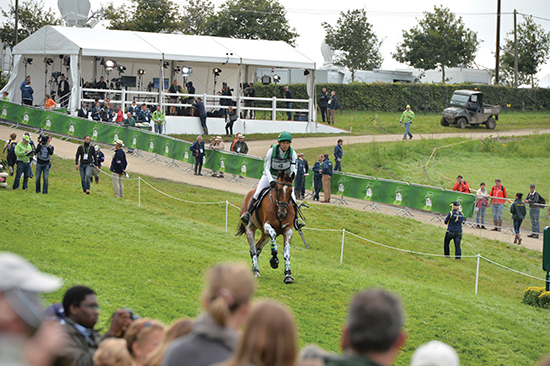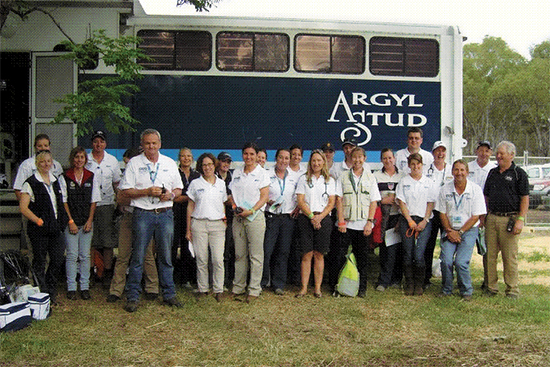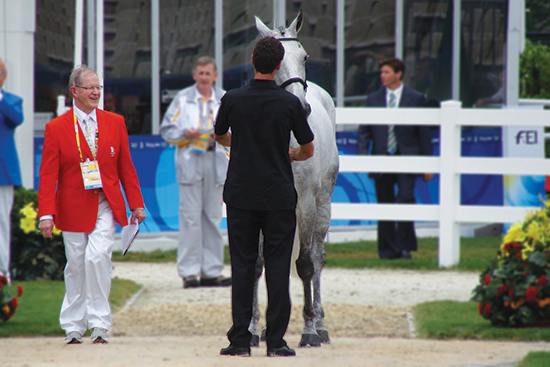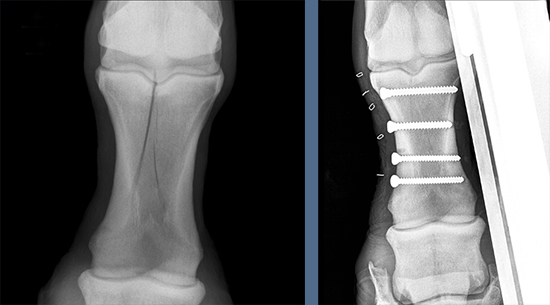 Dr Robin J.W. Bell and Professor Leo Jeffcott
Dr Robin J.W. Bell and Professor Leo Jeffcott
Equine Performance and Imaging Centre, University Veterinary Teaching Hospital Camden
Eventing is a supreme all-round test of a horse’s athletic abilities. Traditionally, the long format three day event had three phases; Dressage, Endurance and Jumping. The Endurance phase consisted of three parts; roads and tracks, steeplechase and cross country. A new format was introduced in 2004 eliminating the roads and tracks and the steeplechase. The event is held over 1, 2 or 3 days, depending on the format of the event (CIC or CCI).
The three phases of eventing provide an exciting assessment of the horse’s overall performance. The Dressage is designed to test the obedience, suppleness, and balance of horses that are fit enough to run cross country the next day. The cross country requires horses to gallop over large fixed obstacles testing the speed, endurance and courage of the horses. The Jumping tests the horse’s ability to compete after the previous days rigorous cross country.
Horses are required to complete all phases in Eventing so they tend to be all-rounders, rather than specialists in any one discipline like the horses we see in pure Jumping or Dressage.
This article will discuss particularly the management of veterinary issues after the cross country phase at CCI events. The cross country phase of the eventing is one of the most demanding disciplines in equestrian competition. Horses must be fit enough to gallop (up to 570m/min) long distances (up to 6.8km) over varied large fixed obstacles (up to 45 jumping efforts). They can sustain a wide range of injuries through contact with the fences, although these are less frequent nowadays with the new frangible pins and collapsible fences, or when galloping across the country. Occasionally minor injuries may result in sufficient lameness to either affect jumping performance or result in the horse not being accepted at the second horse inspection prior to showjumping. This is despite the fact that the horse may end up being sound within a few days after the event.
 The team of 15 Veterinarians required to run the Cross Country phase of the CCI**** in Adelaide
The team of 15 Veterinarians required to run the Cross Country phase of the CCI**** in Adelaide
VETERINARY STRUCTURE IN EVENTING:
Veterinarians officiating at CCI events work at all times under the FEI code of conduct for the Welfare of the Horse which states ‘The health and welfare of the horse must never be subordinated to competitive or commercial interests”. There are a number of veterinarians required at any of these events, all with different roles.
The Veterinary Delegate and Assistant Veterinary Delegate, are the official FEI veterinarians at the event, are tasked, as with the Ground Jury, to ensure that the Veterinary Regulations are complied with, and that the welfare of the horse is not compromised during the event. These veterinarians are responsible for running the Veterinary Examinations of horses on arrival at the venue, the horse inspection prior to dressage and jumping, and the Veterinary Examination after the cross country. The Horse Inspection is run by a panel consisting of the Veterinary Delegate and the Ground Jury. This inspection is to see that the horse is fit to compete both at the start of the event and again before the jumping phase. If the horse is doubtful then a fuller examination in the Holding Box by the Assistant Veterinary Delegate is required.
Professor Leo Jeffcott at the horse inspection for the Beijing Olympic Games
The Veterinary Delegate can also authorize veterinary treatments for horses while in competition. At CCI events there is also an official treating veterinarian who is responsible for overseeing the treatment of horses at these events. All veterinarians working for either riders individually or teams must also be accredited by the FEI. These veterinarians are required to fill out appropriate paperwork (Therapeutic Use Exemption Forms) prior to administering any treatments and all treatments must be performed under supervision of stewards or the Official Treating Veterinarian in dedicated treatment stalls. There are strict penalties for inappropriate medication and doping.
COMMON PROBLEMS AFTER CROSS COUNTRY
We will now outline some common clinical conditions seen at the end of the cross country phase, and will discuss the recommended management and treatments for them.
Heat exhaustion: This is less common in the short format (CIC), but can still occur at CCI**** level, especially on hot/humid days. Initially it can be difficult to tell between a horse that is fatigued after cross country and one that is developing heat stress. Most horses will attempt to drink immediately after exercise and should not be prevented from doing so, but an exhausted horse will be unwilling to move around, drink and does not respond to aggressive cooling. Such horses are usually profoundly depressed, and will not recover without intensive intervention in the form of rapid administration of cooled intravenous fluids, and continuous external cooling. All horses should be aggressively cooled, and their temperatures and vital signs will be monitored by the official veterinarians at the finish of Cross Country until they are sufficiently recovered that they may return to the stables. In very hot and/or humid conditions, the use of large volumes of iced water, and misting fans is often employed at the finish.
Tying up: Exercise induced rhabdomyolysis is less common in high level event horses as most horses that are prone to this condition are weeded out at lower levels. However it still can be encountered, and is seen as a progressive stiffness and unwillingness to move often in the finish area. Depending on severity treatment relies on aggressive cooling of hot/exhausted horses, followed by administration of intravenous fluids. If the horse is very mildly affected then they may be able to complete the competition, but further exercise can exacerbate the condition. If it is a severe case, then treatment with anti-inflammatories such as flunixin is also indicated, such horses will, of course, have to be withdrawn from the competition.
Nose Bleeding after exertion (Epistaxis): Event horses can be prone to bleeding from the nose, which actually originates from within the lungs (exercise induced pulmonary haemorrhage EIPH), is not uncommon in event horses at the end of cross country, and is usually of limited consequence in terms of limiting athletic performance, or the horses welfare. These bleeds are usually self-limiting, and do not require specific treatment.
Stifle fracture: Fractures of the patella are surprisingly common in event horses, usually occurring after ‘leaving a leg’ or knocking a fence on cross country. These may manifest as severe lameness immediately after the fence, or the horse may become progressively lamer after finishing. Diagnosis is made with an x-ray, and treatment/prognosis depends on fracture configuration.
Lacerations: It is not uncommon for horses to sustain cuts on their limbs from contact with cross country fences. Most of these are small and do not require suturing. Some larger lacerations especially those that are actively bleeding will require the horse to be stopped on cross country and treated on the spot. These horses are withdrawn from the competition. Smaller lacerations may still be sutured with the use of small amounts of local anaesthetic if the appropriate ETUE Form is completed.
Overreach injuries: This is probably one of the most common injuries after cross country. Protective bell boots substantially reduce the severity of these injuries, but horses can still sustain significant bruising. These injuries can be the most problematic to treat as while the overall prognosis is excellent the horse can be sufficiently lame that they will not be accepted at the horse inspection. Treatment in competition consists of icing repeatedly overnight.
Tendon and ligament injuries: Tendon and ligament strains after cross country are exceedingly common. High level event horses tend to be older, and often have old chronic tendon issues. Completing the jumping phase with an injured tendon or ligament is contraindicated, as this can cause severe long term damage to the affected structure. For this reason, most horses are withdrawn from competition if they show signs of these injuries. Treatment again consists of cold hosing, icing and anti-inflammatory therapy. Scanning the tendon with an ultrasound machine is often performed at the competition, but this always needs to be repeated a week after injury, to ensure that the full severity of the injury is apparent.
Radiographs taken before and after surgery to repair a split pastern bone that was sustained on cross country at the Beijing Olympic Games. The horse was able to return to competition after the fracture healed.
Other Fractures: Thankfully due to the improvement in cross country fence design, catastrophic fractures of the limbs is very rare during the cross country phase. Less severe fractures of the foot, fetlock and pastern are not uncommon, and may become apparent once the horse has cooled down at the finish, or the horses may show acute severe lameness on course. All major three day events have multiple veterinarians both on course and at the finish line, to deal with just such emergencies. Initial treatment involves bandaging and splinting, followed by x-rays to determine the exact nature of the fracture. Fractures of the pedal bone are generally treated with a bar shoe and rest. Simple fractures of the fetlock and pastern require surgical fixation with screws and a cast, but the prognosis is good for returning to competitive work.
Solar Bruising: Mild-moderate lameness can be caused through bruising of the soles of the feet, especially in horses that throw a shoe on cross country. As with over-reach concussive injuries, these have an excellent prognosis for returning to soundness within 1-2 weeks, however these horses are often very lame the next day. Treatment at the event consists primarily of icing the foot.
CONCLUSION
Eventing is a hazardous competition for both horses and riders. The team of official veterinarians and treating veterinarians are there to assist in getting horses safely through the competition. Their aim is to see as many horses as possible complete the event without serious injury. It is not sensible to hide problems, injuries or treatments as the veterinarians will authorize the most applicable line of treatment for your horse’s condition, irrespective of its competition status.
This article originally appeared in the June 2015 issue of The Horse Magazine.





